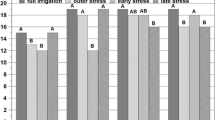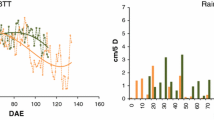Abstract
Research studies have evaluated the production of potatoes (Solanum tuberosum L.) grown in conventional and bed planting configurations. However, intercepted photosynthetically active radiation (PAR) from these planting configurations has not been quantified. A study conducted in 2008 and 2009 quantified and compared the intercepted PAR from three planting configurations (four row conventional ridged-row [4RC], five row bed [5RB], and seven row bed [7RB]), and from different plant spacings of cvs Russet Burbank, Russet Norkotah, and Ranger Russet potatoes under sprinkler irrigation. A second study was conducted in 2007 to evaluate the relationship between PAR and leaf area of Russet Norkotah and Russet Burbank for the three planting configurations. These studies were conducted at the USDA-ARS Northwest Irrigation & Soils Research Lab in Kimberly, ID, on a Portneuf silt loam (coarse–silty mixed mesic Durixerollic Calciorthid). The canopy of Russet Norkotah and Ranger Russet potatoes grown in 5RB and 7RB planting configurations intercepted more PAR during the early vegetative and tuber initiation growth stages compared to the 4RC planting configuration at equal populations in 2008 and 2009 at all measurement dates. The canopy of Russet Burbank intercepted more PAR during the early growth stage in 2008 when planted in the bed planting configurations compared to the 4RC planting configuration, but not on the July 17, 2008 and July 9, 2009 dates. The canopy cover of Russet Burbank potatoes planted in the 4RC planting configuration tended to catch up with the bed planting configurations quicker than the other two cultivars. In general, the quantity of PAR intercepted as affected by planting configuration did not influence total tuber yield and other measured production variables. Cumulative PAR interception 0–72 days after planting (DAP) was increased 35%, 38%, and 32% for the 5RB and 65%, 69%, 23% for the 7RB relative to the 4RC planting configuration for Ranger Russet, Ranger Norkotah, and Russet Burbank, respectively. Cumulative PAR interception for the season was increased 15%, 16%, and 4% for the 5RB and 23%, 23%, 5% for the 7RB relative to the 4RC planting configuration for Ranger Russet, Ranger Norkotah, and Russet Burbank, respectively. The relationship between intercepted PAR and leaf area for Russet Norkotah during the early vegetative and tuber initiation growth stages was significantly different between the three planting configurations, with intercepted PAR at a given leaf area in the order of 7RB>5RB>4RC. For Russet Burbank, the relationship was significantly different for the 5RB and 7RB compared to 4RC planting configuration only, with intercepted PAR at a given leaf area in the order of 7RB=5RB>4RC.





Similar content being viewed by others
References
Alva AK, Hodges T, Boydston RA, Collins HP (2002) Effects of irrigation and tillage practices on yield of potato under high production conditions in the Pacific Northwest. Com Soil Sci Plant Anal l33:1451–1460
Analytical and Software (2003) Statistix 8 Analytical and Software, Tallahassee, FL
Bohl WH, Olsen N, Love SL, Nolte P (2003) Chapter 7: Seed and Planting Management. In: Stark JC, Love SL (eds) Potato Production Systems. University of Idaho Cooperative Extension System, Moscow, ID
Boyd NS, Gordon R, Martin RC (2002) Relationship between leaf area index and ground cover in potatoes under different management conditions. Potato Res 45:117–129
Burstall L, Harris PM (1983) The estimation of percentage light interception from leaf area index and percentage ground cover in potatoes. J Agric Sci Camb 100:241–244
Essah SYC, Honeycutt CW (2004) Tillage and seed-sprouting strategies to improve potato yield and quality in short season climates. Am J Potato Res 81:177–186
Fahem M, Haverkort AJ (1988) Comparison of the growth of potato crops in autumn and spring in North Africa. Potato Res 31:557–568
Firman DM, Allen EJ (1989) Relationship between light interception, ground cover and leaf area index in potatoes. J Agric Sci Camb 113:355–359
Fisher A, Bailey RJ, Williams DJ (1993) Growing potatoes using a bed-planting technique. Soil Management in Sustainable Agriculture; Proceedings of the Third International Conference on Sustainable Agriculture, Wye College University of London, pp. 561–568.
Frederick JR, Bauer PJ, Busscher WJ, McCutcheon GS (1998) Tillage management for doublecropped soybean in narrow and wide row width culture. Crop Sci 38:755–762
Haverkort AJ, Harris PM (1986) Conversion coefficients between intercepted radiation and tuber yields in potato crops under tropical highland conditions. Potato Res 29:529–533
Haverkort AJ, Uenk D, Veroude H, van de Waart M (1991) Relationships between ground cover, intercepted solar radiation, leaf area index and infrared reflectance of potato crops. Potato Res 34:113–121
Jefferies RA, MacKerron DKL (1989) Radiation interception and growth of irrigated and droughted potato. Field Crops Res 22:101–112
Khurana SC, McLaren JS (1982) The influence of leaf area, light interception and season on potato growth and yield. Potato Res 25:329–342
King BA, Tarkalson DD, Bjorneberg DL, Taberna JP Jr (2011) Planting configuration effect on yield response of Russet Norkotah to irrigation and nitrogen under high application rate sprinkler irrigation. Am J Potato Res 88:121–134
Kleinkopf GE, Westermann DT, Dwelle RB (1981) Dry matter production and nitrogen utilization by six potato cultivars. Agron J 73:799–802
Kooman PL, Fahem M, Tegera P, Haverkort AJ (1996) Effects of climate on different potato genotypes 1. Radiation interception, total and tuber dry matter production. Eur J Agron 5:193–205
Lynch DR, Rowberry RG (1977) Population density studies with Russet Burbank II. The effect of fertilization and plant density on growth, development and yield. Am Potato J 54:57–71
Manrique LA, Kiniry JR, Hodges T, Axness DS (1991) Dry matter production and radiation interception of potato. Crop Sci 31:1044–1049
Meek DW, Hatfield JL, Howell TA, Idso SB, Reginato RJ (1984) A generalized relationship between photosynthetically active radiation and solar radiation. Agron J 76:939–945
McKeown AW (1987) Increased yield of small seed tubers of Yukon Gold potatoes using multiple-row beds. Canadian J Plant Sci 67:365–367
Nelson DC (1967) Effects of row spacing and plant populations on yields and tuber-size of potatoes. Am Potato J 44:17–21
Pavlista A (2010) CropWatch: Potato education guide. University of Nebraska-Lincoln Cooperative Extension. http://cropwatch.unl.edu/potato. Accessed 22 November 2010.
Pehrson L, Mahler RL, Bechinski EJ, Williams C (2010) Water management practices used in potato production in Idaho. Am Potato J 87:253–260
Prestt AJ, Carr MKV (1984) Soil management and planting techniques for potatoes. Aspects of Appl Biol 7:187–204
Robinson D (1999) A comparison of soil water distribution under ridge and bed cultivated potatoes. Agr Water Manag 42:189–204
SAS (2007) Statistical Analysis Software version 9.1.3. Statistical Analysis Institute, Inc, Cary
Saffigna PG, Tanner CB, Keeney DR (1976) Non-uniform infiltration under potato canopies caused by interception, stemflow and hilling. Agron J 68:337–342
Sibma L (1970) Relationship between total radiation and yield of some field crops in the Netherlands. Neth J Agr Sci 18:125–131
Tarkalson DD, King BA, Bjorneberg DL, Taberna JP Jr (2011) Evaluation of in-row plant spacing and planting configuration for irrigated Russet Burbank, Russet Norkotah, and Ranger Russet potatoes. Am J Potato Res 88:201–217
Thompson R, Gray D, Pascal JA (1974) Potatoes for canning—design of growing systems. J Agr Sci Cambridge 82:233–243
Tollenaar M, Bruulsema TW (1988) Efficiency of maize dry matter production during periods of complete least area expansion. Agron J 80:580–585
Waddell JT, Gupta SC, Moncrief JF, Rosen CJ, Steele DD (2000) Irrigation- and nitrogen-management impacts on nitrate leaching under potato. J Environ Qual 29:251–261
Wayman JA (1969) Experiments to investigate some of the problems in mechanisation associated with the cultivation of potato beds. Euro Potato J 12:200–214
Author information
Authors and Affiliations
Corresponding author
Rights and permissions
About this article
Cite this article
Tarkalson, D.D., King, B.A., Bjorneberg, D.L. et al. Effects of Planting Configuration and In-Row Plant Spacing on Photosynthetically Active Radiation Interception for Three Irrigated Potato Cultivars. Potato Res. 55, 41–58 (2012). https://doi.org/10.1007/s11540-011-9205-2
Received:
Accepted:
Published:
Issue Date:
DOI: https://doi.org/10.1007/s11540-011-9205-2




